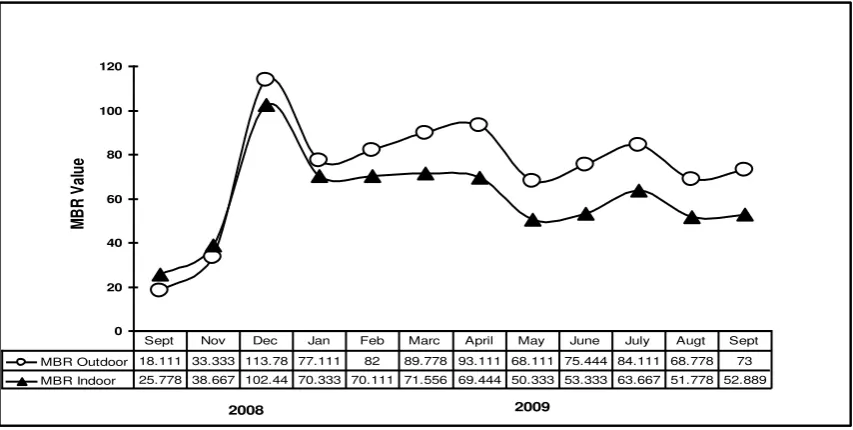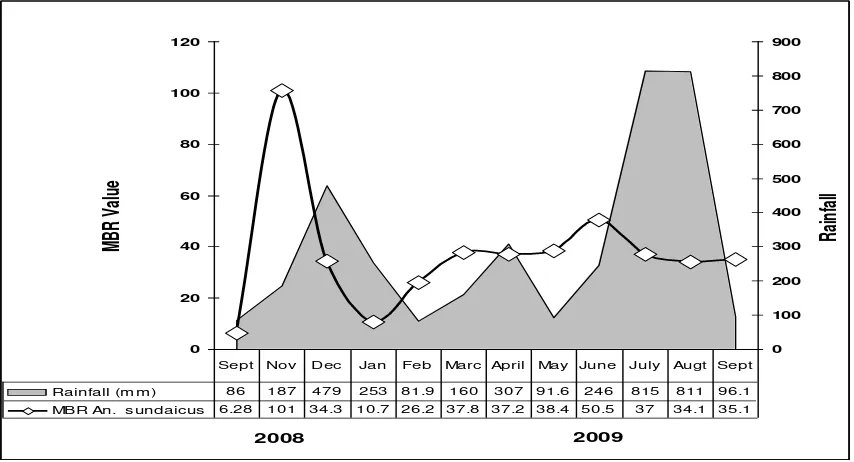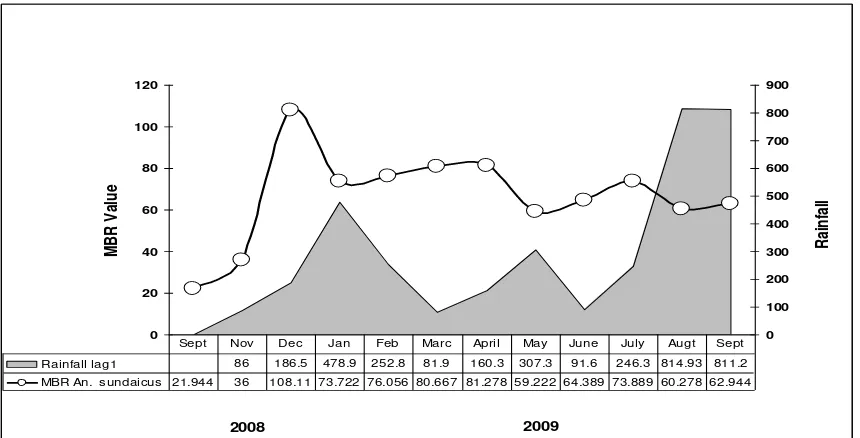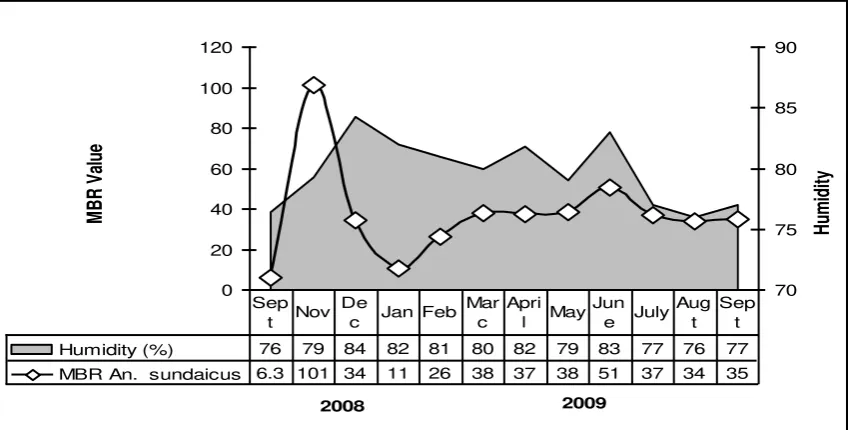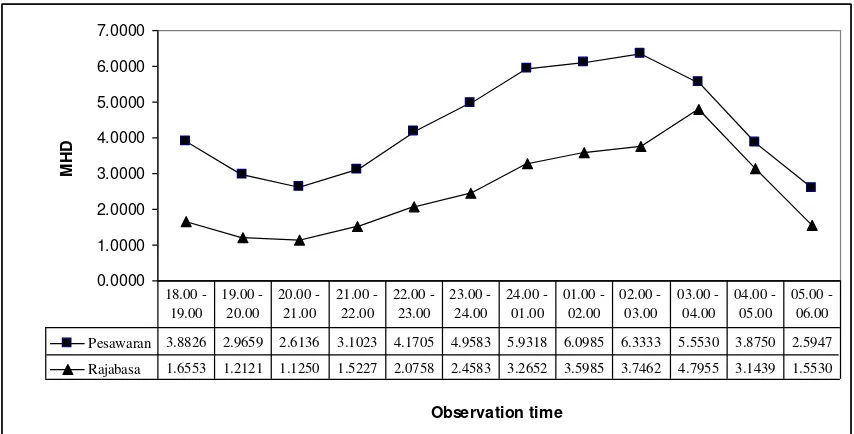1 National Institute of Health Research and Development, Indonesia
BEBERAPA ASPEK PERILAKU VEKTOR MALARIA NYAMUK
AN.
SUNDAICUS
(THEOBALD) DI LAMPUNG, SUMATERA
Some Aspect Of Behavior Of Malaria Vector Anopheles Sundaicus (Theobald) In
Lampung, Sumatera
Supratman Sukowati1, Shinta1, Suwito2, Amelia Savitri3, William Hawley4,
Tom Burkot5, Neil Lobo5, and Frank Collins5
Abstrak. Malaria merupakan salah satu penyakit tular vektor yang menjadi masalah kesehatan masyarakat, dan masih sering menimbulkan kejadian luar biasa di Indonesia. Dari 82 spesies Anophele yang ditemukan, diantaranya telah dikonfirmasi dapat berperan sebagai vektor malaria di Indonesia. Pengendalian vektor masih merupakan salah satu cara intervensi yang effektif untuk memutus rantai penularan malaria, oleh karena itu pemahaman tentang bio-ecologi s merupakan hal penting sebagai dasar untuk menentukan strategi pengendaliannya. Beberapa aspek perilaku vektor mempunyai dampak langsung dan tidak langsung untuk menentukan intervensi pencegahan dan pengendalian malaria. Penelitian dilakukan dengan human landing (HLC) dan resting collection. Artikel ini membahas hasil penelitian tentang beberapa aspek perilaku vektor malaria dari populasi Lampung pada bulan September 2008-bulan Agustus 2009.Sembilan spesies nyamuk Anopheles ditemukan di dua daerah di Lampung selama penelitian, yaitu: An. sundaicus, An. vagus, An. tesselatus, An. barbirostris, An. vagus, An.minimus, An. aconitus, An. subpictus, dan An.annularis, dan nyamuk An. sundaicus merupakan spesies yang dominan yang berperan sebagai vektor malaria. Kepadatan populasi nyamuk An. sundaicus yang dinyatakan dalam man biting rate () di Padang Cermin di luar rumah 18,1 pada bulan September 2008 dan 113,78 pada bulan Desember 2008, sedangkan di dalam rumah berturut turut dari 25,78 and 102. 44 pada bulan September dan Desember 2008. Nyamuk An. sundaicus di daerah Lampung cenderung bersifat outdoor biter, disamping itu kepadatan populasi di dalam dan di luar rumah tidak saling mempengaruhi. Puncak kepadatan dari An. sundaicus dilaporkan terjadi pada bulan Nopember pada waktu itu masih musim kemarau, dan puncak kepadatan kedua terjadi pada bulan Maret dan bulan April, serta bulan Juni 2009. Selama musim kemarau kepadatan populasi cenderung lebih tinggi dibanding musim penghujanPopulasi An. sundaicus di daerah penelitian ditemukan aktif menghisap darah sepanjang malam, mulai aktif dari matahari terbenam, berlansung sepanjang malam sampai matahari terbit danpuncak aktivitasnya beragam dari waktu ke waktu. Namun demikian, lebih banyak ditemukan puncak aktivitas terjadi setelah tengah malam sampai pukul tiga pagi. Nyamuk An. sundaicus di daerah Lampung bersifat anthropophilic, exophagic, and exophilic. Spesies ini hanya ditemukan dalam jumlah yang sangat kecil hinggap di dalam rumah, disamping itu juga tidak mudah menemukannya beristirahat di luar rumah di dua daerah penelitian.
Kata kunci: Malaria, An. sundaicus, population dynamic, biting activity, vector control
on December 2008, and the range of MBR outdoor from 18.11 occurred on September, and 113.78 occurred on December 2008. This species tend to be outdoor biter in this area, there is a significant different between outdoor and indoor biting, therefore indoor and outdoor densities are independent. There are no interferences between indoor and outdoor biting activities. The peaks season of An. sundaicus were observed on November, and secondary peaks observed on March and April and another small peaks occurred on June 2009. During the dry season the density tend to grow up and always higher then rainy season. The biting activities of An. sundaicus in both areas occurred throughout the night, the biting activity start after down up to the morning, and the peak activities varies from time to time. Though most of the biting peak occurred after midnght to three a.m. in the morning. This species in Lampung is anthropophilic, and exophagic. The mosquito was found very small number resting in the house, therefore there was not easy to found the outdoor resting site in Lampung.
Keywords: Malaria, An. sundaicus, population dynamic, biting activity, vector control
INTRODUCTION
Malaria remains a serious human health , transmission typically being rural and localized, depending on the presence of competent malaria vectors (Sukowati, 2008). The annual parasite incidence (API) at the provincial level during 1999 ranging from 0.12-9.97 in Java and Bali, and in outer islands annual malaria incidence (AMI) ranging from 3%0 -168.41%0. During the
year 2001 average of API in Java – Bali is 0.63%0 and average AMI in outer inland is
25.40%0. According to the National Health
Household Survey in 1995, 2 % of all deaths were caused by malaria. This means around 32,000 deaths in one year. 2007), the national malaria prevalence was 2.85 %, ranging from 0.2% -26.1%. The malaria prevalence in Lampung Province was 1.42%
In 1998, it was reported that 46.2% of the 210.6 million total Indonesian populations lived in malaria endemic areas and among these, 56.3 million living in moderate to high-risk areas. There were 3.33 million clinically suspected malaria cases of which 196,332 laboratory-confirmed cases, 80% from Java and Bali and the remaining were from outer islands. The malaria almost occurred in all over Districts.
In year 2003 the annual parasite incidence in Java-Bali ranges from 0.03-022
‰, and in the outer islands the annual
malaria incidence ranges from
2.31-127.89‰. In year 2007 estimated 46.2% of Indonesian live in the malaria transmission risk area, and reported endemic district is 309 (70%) out of 441 districts, and the number of reported cases is 311,78 ( Sukowati, 2008). Nowdays the malaria cases tend to icrease, and outbreak occurred from
several areas, mostly from villages which is the access to health services is difficult.
Vector control remains the most effective measure to prevent malaria transmission. Understanding mosquito behavior, population dynamics, and the risk of transmission are necessary for the design and evaluation of efficient control measures against malaria.
Entomological studies are needed to provide practical solutions to clearly define control-oriented research questions. Any malaria control strategy should be based on a thorough understanding of the transmission of the disease including the epidemiological variables, the behavior of the human host, the parasite, and the environment. One of the confirmed to be malaria vectors. Bio-ecology studies have explored vectors in Central Java, Lombok and Sulawesi. However, in most cases, information on vector behavior and ecology are still needed in many of the malaria endemic areas of Indonesia including those islands where An sundaicus is found.
1 National Institute of Health Research and Development, Indonesia
water (Bonne-Webster and Swengrebell 1953; Sukowati et al 1996) and to be primarily exophilic, except in Kampung Laut Cilacapwhere it is endophilic and resistant to DDT (Kirnowardoyo and Gambiro 1987)). This present paper reports the population dynamic sand biting activities of the An. sundaicus population from Lampung, Sumatra.
Malaria remains a serious threat to human health in Indonesia, its transmission is typically rural and localized, and the risk of transmission at each site depends on the presence or absence of competent malaria vectors. In 1998, it was reported that 46.2% of the 210.6 million total Indonesian populations lived in malaria endemic areas and among these, 56.3 million living in moderate to high-risk areas. The annual parasite incidence (API) at the provincial level during 1999 ranging from 0.12-9.97 in Java and Bali, and in outer islands annual malaria incidence (AMI) ranging from 3%0
-168.41%0. During the year 2001 average of
API in Java – Bali is 0.63%0 and average of
AMI in outer inland is 25.40%0. According
to the National Health Household Survey in 1995, 2 % of all deaths were caused by malaria. This means around 32,000 deaths in one year. Data from baseline survey of health in 2007, malaria cases distributed unequally in Indonesia. The national clinical malaria cases are 2.9% with a range of 0.2%-26.1%, three provinces with highest malaria cases are West Papua (26.1%), Papua (18.4%) and East Nusatenggara (12%). Therefore during 2010, the average of API in Java-Bali is quite low 0.126%0, with the range of 0 - 3.13%0,
and the average of API in the outer islands is 10.025%0 with the range of 0- 217.69%0
Indonesia consists of approximately 17.508 islands located between 6 degrees north and 11 degrees south latitude, and from 95 to 141 degrees east longitude. The Indonesian archipelago lies between two continents Asia and Australia. There are five major islands: Sumatra, Java, Kalimantan, Sulawesi and Papua. Two remaining groups of islands are Mollucas and Nusa Tenggara. Other islands are small and many of them uninhabited. Indonesia’s climate is tropical with two season, dry season extend from
May to October, and rainy season from November to April. Many populations live in
Small Island’s area, arid and high mountain
zones, and in densely populated coastal areas, poor people are considered to be particularly vulnerable to malaria. Another characteristic of Indonesia has very rich and wide variety of insects as disease vectors, especially mosquitoes (Sukowati, S. 2010).
Indonesia malaria vectors exhibit a wide range of biting behaviors with many species biting outdoors in the early part of the night and evening, placing residents at risk from contracting malaria and undermining the efficacy of control measures such as insecticide-treated nets or indoor residual spraying. We therefore propose to rigorously evaluate the behaviors of the primary malaria vectors in Indonesia and to optimize a protocol for operational sampling of malaria vectors which is robust to variations in vector behavior, notably variations associated with the presence of important malaria control methods. 2
One of the most important outcome measures used for monitoring and evaluation of any malaria control programmed is the biting density of adult mosquitoes, notably
Anopheles malaria vectors (Service, 1977). The measurement of human exposure to malaria requires trapping of host-seeking mosquito vectors to determine their biting density and infection rate (Beier et al., 1999; Hay et al., 2000; Robert et al., 2003). Despite its central role in malaria epidemiology, sampling of host-seeking adult Anopheles
remains problematic and all available methods suffer from significant drawbacks (Service, 1977). The gold standard for estimating rates of malaria transmission based on entomological measures has been the human landing catch.
bite humans (Pates & Curtis 2005; Killeen et al., 2006). Bio-ecology studies have been thoroughly explored on certain vectors in Central Java, Lombok, South Halmahera, and Sulawesi. However, in most cases information regarding the vector behavior and ecology are still needed in certain malaria endemic areas.
MATERIALS AND METHODS
This study was carried out in medium endemic area in two districts of Lampung Province, Sumatra: e.g. a) South Lampung District and Pesawaran District, from September 2008 to September 2011. Both study sites a coastal, rural villages with fisheries in Padang Cermin, as well as rice paddies and home gardens.
The techniques used to sample mosquitoes seeking human blood are conducted indoors, outdoors and in resting habitat. Resting collections are often made from outdoor natural shelters, such as vegetation and tree-holes, but a few important vector species can be found in man-made structures.
In each area, indoors and outdoors landing collections for mosquitoes were conducted monthly from 18.00 to 06.00 am, with resting collections from morning when mosquitoes are resting. Each technique collection was made 4 times in each area every month , h. The indoor capture-stations also contained their normal occupants. Mosquito collectors should take an
appropriate and effective antimalarial prophylaxis to avoid contracting malaria during collection of biting mosquitoes. one collector is seated indoor and another is seated outdoor. Collectors work in shifts during the night. The collections were identified either at night or in the morning, and all the anopheline species were put in the vial individually for circumsporozoite (CS antigen) examination by ELISA test.
RESULTS AND DISCUSSION
1 National Institute of Health Research and Development, Indonesia 2008
0 20 40 60 80 100 120 140
2009
M
B
R
V
al
ue
MBR Outdoor 5.778 126.9 38.67 12.33 29 42.89 44.67 45.89 59.78 43.33 40.22 41.33
MBR Indoor 6.778 75.22 29.89 9 23.33 32.67 29.78 30.89 41.22 30.67 27.89 28.89
Sept Nov Dec Jan Feb Marc April May June July Augt Sept
Figure 1. Monthly population density of Anopheles sundaicus at Rajabasa, Lampung in 2008-2009
The population density of An. sundaicus at Padang Cermin was slightly higher than in Rajabasa where An. sundaicus
was also the predominant species. The indoor and outdoor MBR at Padang Cermin ranged from 25.8 and 18.1, respectively, n September 2008 to 102.4 and 113.8
December 2008 (Figure 2). The combined indoor and outdoor MBR at Padang Cermin ranged from 6.3 to 101.1. The peaks season of An. sundaicus at Padang Cermin was observed on November, and secondary peaks were observed on March, April and another small increase occurred on June 2009.
2008 0
20 40 60 80 100 120
2009
M
B
R
V
al
u
e
MBR Outdoor 18.111 33.333 113.78 77.111 82 89.778 93.111 68.111 75.444 84.111 68.778 73
MBR Indoor 25.778 38.667 102.44 70.333 70.111 71.556 69.444 50.333 53.333 63.667 51.778 52.889
Sept Nov Dec Jan Feb Marc April May June July Augt Sept
Figure 2. Monthly population density of Anopheles sundaicus at Padang Cermin, Lampung in 2008-2009
During dry season the population density of An. sundaicus in both areas was higher than during the rainy season. This species tend to be outdoor biter, there is a significant different between outdoor and indoor biting (population at Rajabasa t= 0.0001; and population at Padang Cermin t=0.0000), therefore indoor and outdoor densities are independent. There are no interferences between indoor and outdoor biting activities (figure 1 and 2).
The climate factors are important determinants of mosquito survival and population growth., rainfall data is presented
with the monthly densities of An. sundaicus
(Figure 3), and igure 4 provides rainfall lag one month ahead with monthly density of An. sundaicus at Rajabasa area. There was an association between An. sundaicus density and rainfall within one month lag (P>t=0.0233) at Rajabasa population. However there were no associations between relative humidity, temperature and rainfall at the same month at Rajabasa population (Figure 5, 6 and 9). The population density of
An. sundaicus tend to increase whenever less rainfall or during dry season (Figure 3, 4 and 5).
0 20 40 60 80 100 120
Ra
in
fa
ll
M
BR
V
al
ue
0 100 200 300 400 500 600 700 800 900
2008 2009
Rainfall (m m ) 86 187 479 253 81.9 160 307 91.6 246 815 811 96.1
MBR An. s undaicus 6.28 101 34.3 10.7 26.2 37.8 37.2 38.4 50.5 37 34.1 35.1
Sept Nov Dec Jan Feb Marc April May June July Augt Sept
1 National Institute of Health Research and Development, Indonesia
0 20 40 60 80 100 120
R
a
in
fa
ll
M
B
R
V
a
lu
e
0 100 200 300 400 500 600 700 800 900
2008 2009
Rainfall lag1 86 186.5 478.9 252.8 81.9 160.3 307.3 91.6 246.3 814.93 811.2
MBR An. sundaicus 6.2778 101.06 34.278 10.667 26.167 37.778 37.222 38.389 50.5 37 34.056 35.111
Sept Nov Dec Jan Feb Marc April May June July Augt Sept
Figure 4. Correlation between Population Density and Rainfall lag at Rajabasa , South Lampung, Lampung
There was no association or correlation between An. sundaicus density and rainfall, as well as rainfall lag and temperature at Padang Cermin population (Figure 5, and 7). However, there was a correlation between relative humidity and population density at the Padang Cermin population ( t =0.0227, y= -340 x2+5.11x and
x2 =0.405) (Figure 9). Similar with Rajabasa
population pattern, the density of An. sundaicus increase whenever less rainfall or during dry season (Figure 4). Although the landing density of An. sundaicus was quite high during wet season, the density lower during the dry season in both the Rajabasa and Padang Cermin populations.
R
Rainfall lag1 86 186.5 478.9 252.8 81.9 160.3 307.3 91.6 246.3 814.93 811.2
MBR An. s undaicus 21.944 36 108.11 73.722 76.056 80.667 81.278 59.222 64.389 73.889 60.278 62.944
Sept Nov Dec Jan Feb Marc April May June July Augt Sept
Figure 5. Correlation between Population Density and Rainfall lag 1 month at Padang Cermin,
Tem perature (C) 26.9 25.6 26.1 26.2 26.5 27.1 26.1 27.1 26.4 26.3 26.1 27.3
MBR An. s undaicus 6.28 101 34.3 10.7 26.2 37.8 37.2 38.4 50.5 37 34.1 35.1
Sept Nov Dec Jan Feb Marc April May June July Augt Sept
Figure 6. Correlation between Population Density and Temperature at Rajabasa , South Lampung, Lampung Cermin (Figure 10). An. sundaicus is a night biter and active throughthe night; biting activity started after dusk and continued to the morning and the peak activities varies
from time to time and places. The indoor and outdoor biting patterns of An. sundaicus at both areas was similar, but the Pesawaran population wasalways higher than the Rajabasa population. The highest numbers of
1 National Institute of Health Research and Development, Indonesia
Temperature (C) 26.9 25.6 26.1 26.2 26.5 27.1 26.1 27.1 26.4 26.3 26.1 27.3
MBR An. sundaicus 21.944 36 108.11 73.722 76.056 80.667 81.278 59.222 64.389 73.889 60.278 62.944
Sept Nov Dec Jan Feb Marc April May June July Augt Sept
Figure 7. Correlation between Population Density and Temperature at Padangcermin , Pesawaran District , Lampung
Figure 8. Correlation between Population Density and Relative Humidity at Rajabasa, South Lampung District, Lampung
This species is anthropophilic, exophagic, and exophilic. The population of
An. sundaicus behavior are slightly difference from area to area, at the coastal area in Purworejo tend to be
easy to found the outdoor resting site of these occurred on September – November at 24.00-02.00.
MBR An. s undaicus 21.944 36 108.11 73.722 76.056 80.667 81.278 59.222 64.389 73.889 60.278 62.944
Sept Nov Dec Jan Feb Marc April May June July Augt Sept
Figure 9. Correlation between Population Density and Relative Humidity at Padangcermin, Pesawaran District, Lampung
0.0000
Pesawaran 3.8826 2.9659 2.6136 3.1023 4.1705 4.9583 5.9318 6.0985 6.3333 5.5530 3.8750 2.5947 Rajabasa 1.6553 1.2121 1.1250 1.5227 2.0758 2.4583 3.2652 3.5985 3.7462 4.7955 3.1439 1.5530
18.00 -
Figure 10. Biting Activities of Anopheles sundaicus at Rajabasa and Pesawaran Districts, Lampung in 2008-2009
CONCLUSION AND SUGGESTION There were no differences between indoor and outdoor biting activities. The peak density of An. sundaicus was observed n throughout the night, beginning after p = 0.0227
1 National Institute of Health Research and Development, Indonesia
sundown and continuing until sunrise peak biting occurring between midnght and three a.m.. This species was found to be anthropophilic, exophagic, and exophic. Small numbers of An sundiacus were found resting in houses, therefore there was not easy to found the outdoor resting site of these two species in this areas
We suggest of: a) having a surveillance of An. sundaicus population together with a malaria cases in the studies area periodically, and b) reducing the malaria transmission by source reduction by environmental management and community involvement.
AKNOWLEDGEMENT
The author wish to thank to Bill Gate foundation for the funding, Unicef Indonesia for the coordination. We are especially grateful to a National Institute of Health Research and Development, Ministry of Health, Jakarta for it support and facilities for this research. Sincere thanks are extended to all staff and technician for their cooperation. This article is part of the malaria transmission (MTC) project which is coordinated by UNICEF, Indonesia and Notre Dame University.
REFERENCES
Dusfour, I., Y. Linton, A. Cohuet, R. E. Harbach, V. Baimai, H.D. Trung, Ch. M Seng, A. Matusop and Sy. Manguin. 2004. Molecular evidence of speciation between island and continental populations of Anopheles (Cellia) sundaicus (Diptera: Culicidae), a principal malaria vector taxon in Southeast Asia. J. Med. Entomol. 41: 287-295.
Garjito, AGF, Jastal, Wijaya, Y, Lili, Siti Chatijah, Erlan, A, Rosmini, Samarang, Udin Y, Labatjo,Y. Studi Bioekologi nyamuk Anopheles di wilayah pantai timur Kabupaten Parigi-Moutong, Sulawesi Tengah. 2004; Bull Pen Kes. 32 (2) : 49-61 Hoedoyo. Bionomics of Anopheles barbirostris Van der
Wulp in several areas in Indonesia. 18th
Annual Scientific Seminar of the Malaysia Society of Parasitology and Tropical Medicine in Penang, Malaysia. 1982. 12 pp. Imai, C., T. Ikemoto, M. Takagi, H. Yamugi, W.
Pohan, H. Hasibuan, H. Sirait. 1988. Ecological study of Anopheles sundaicus
larvae in a coastal village of North Sumatra, Indonesia. I. Topography, land use, and larval breeding. Jpn. J. Sanit. Zool. 39: 293-300. Joshi GP, Self L S, Salim Usman, Pant C P, Nelson M
J, and Supalin. Ecological studies on Anopheles aconitus in the Semarang area of Central Java, Indonesia. World Health Organization 1977; WHO/VBC/77.677. Boston. 555 pp.
Nyoman Kandun I. Kebijakan Nasional Pengendalian Penyakit yang ditularkan Nyamuk. Keynote speaker Direktur Jendral PP&PL DepKes RI. Disampaikan pada Simposium & Seminar Nasional Asosiasi Pengendalian Nyamuk Indonesia (APNI) di FK UNHAS Makassar, 23 Agustus 2008
O'Connor, C. T. and A. Soepanto. 1989. Illustrated key to female Anophelines of Indonesia. Directorate of Communicable Disease, Ministry of Health, Jakarta. 40 pp. Ramachandra Rao T The anopheline of India. Indian council of Medical Research New Delhi, Malaria Research Centre (ICMR), Delhi Press, New Delhi. (1981).
Reid JA, Harrison BA and Atmosoedjono S Variation and vector status in Anopheles barbirostris. Mosquito systematics (1979;. 11 (3): 235-251.
Reid, J.A., B. A. Harrison and S. Atmosoedjono. 1979. Variation and vector status in Anopheles barbirostris. Mosq. Syst. 11: 235-251. Santiyo Kirnowardoyo. Anopheles malaria vector and
control measures applied in Indonesia. Southeast Asian J.Trop.Med Pub. Hlth 1988; 713-716.
Sharma, S. K., T. Adak, S. Haq and I. Kar. 1999. Observations on the relationship of salinity with breeding habitats of Anopheles sundaicus (Diptera: Culicidae) at Car Nicobar Island, India. Mosquito-borne Disease Bulletin. 16: 33-36.
Sub Direktorat Malaria. Keadaan malaria di Jawa-Bali tahun: 1994-2003. Dorektorat Jendral Pencegahan Pemberantasan Penyakit Menular & Penyehatan Lingkungan Pemukiman. Jakarta 2004b.
Subbarao SK, Vasantha K, Adak T, and Sharma VP. Anopheles culicifacies. Evidence for a new sibling species, species C. Ann. Entomol. Soc. Amer. 1983; 76:985-988
Sukowati S. Pendekatan ekosistem dalam pengendalian nyamuk (vektor penyakit). Proceeding Seminar Nasional dan symposium Strategi Pengendalian Nyamuk sebagai Vektor tular penyakit dalam upaya peningkatan kualitas kesehatan masyarakat. Fakultas Kesehatan Masyarakat Universitas Diponegoro; 2006. 91-99.
Sukowati S., H. Andris, J. Sondakh dan Shinta. Penelitian Spesies Sibling nyamuk Anopheles barbirostris Van Der Wulp di Indonesia. J Ekologi Kes. 2005; Vol 4 (1); 172-180 Sukowati, dkk. 2001. Penelitian Bioekologi Vektor Di
Laporan Penelitian Puslitbang Ekologi Kesehatan. DEPKES RI. Jakarta
Sukowati, S. 2000. Studi genetika populasi vector malaria and filariasis nyamuk Anopheles barbirostris di Indonesia. Riset Unggulan Terpadu v. 2. Kantor Menteri negara riset dan teknologi dwan riset nasional. 46 pp. Netherlands.
Sukowati, S. Masalah Keragaman spesies vektor malaria dan cara pengendaliannya di Indonesia. Prosiding Orasi Pengukuhan Profesor Riset bidang Entomologi, Badan
Penelitian dan Pengembangan Kesehatan RI; 2008.
Sukowati, S. V. Baimai, S. Harun, Y. Dasuki, H. Andris, and E. Efriwati. 1999. Isozyme evidence for three sibling species in the Anopheles sundaicus complex from Indonesia. Med. Vet. Entomol. 13: 408-414. Yusniar, A., Wigati, H. Andris and S. Sukowati. 2011.
